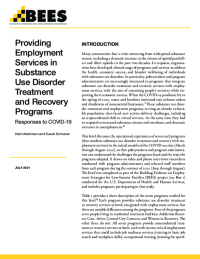Providing Employment Services in Substance Use Disorder Treatment and Recovery Programs
Response to COVID-19

 Many communities face a crisis stemming from widespread substance misuse, including a dramatic increase in the misuse of opioid painkillers and illicit opioids in the past two decades. In response, organizations have developed a broad range of programs and services to address the health, economic success, and broader well-being of individuals with substance use disorders. In particular, policymakers and program administrators are increasingly interested in programs that integrate substance use disorder treatment and recovery with employment services, with the aim of sustaining people’s recovery while improving their economic success.
Many communities face a crisis stemming from widespread substance misuse, including a dramatic increase in the misuse of opioid painkillers and illicit opioids in the past two decades. In response, organizations have developed a broad range of programs and services to address the health, economic success, and broader well-being of individuals with substance use disorders. In particular, policymakers and program administrators are increasingly interested in programs that integrate substance use disorder treatment and recovery with employment services, with the aim of sustaining people’s recovery while improving their economic success.
When the COVID-19 pandemic hit in the spring of 2020, states and localities instituted stay-at-home orders and shutdowns of nonessential businesses. These programs that combined substance use disorder treatment and recovery with employment services, and served an already vulnerable population, then faced new service-delivery challenges, including an unprecedented shift to virtual services. At the same time, they had to respond to increased substance misuse and overdoses and dramatic increases in unemployment.
This brief discusses the operational experiences of seven such programs in the initial months of the COVID-19 crisis. The brief was completed as part of the Building Evidence on Employment Strategies for Low-Income Families (BEES) project and includes seven programs participating in that study.
Primary Research Questions
This brief discusses the experiences of the programs in providing both substance use disorder treatment and recovery services and employment services from March through August 2020. The research questions are:
- How did the programs respond to the challenges they faced and what adaptations did they make in the delivery of substance use treatment and recovery services during the early stages of the pandemic?
- How did the programs respond to the challenges they faced and what adaptations did they make in the delivery of employment services during the pandemic?
Purpose
Policymakers and program administrators are increasingly interested in programs that integrate substance use disorder treatment and recovery with employment services, with the aim of sustaining people’s recovery while improving their economic success. These programs, serving an already vulnerable population, faced new service delivery challenges with the onset of the COVID-19 pandemic: At the same time, they had to respond to increased substance misuse and overdoses, dramatic increases in unemployment, and an unprecedented shift to virtual services. This brief discusses the operational experiences of several programs in the initial months of the COVID-19 crisis, specifically during the spring and summer of 2020, so that policymakers and program administrators can understand the challenges they faced and the ways they adapted.
Key Findings and Highlights
The programs studied for this brief responded quickly and creatively to address the challenges that arose during the initial months of the pandemic. They adapted to try to continue meeting the needs of an already vulnerable population who faced an unprecedented disruption to their lives. All the programs had the dual goals of continuing services while ensuring the safety of participants and staff members. Viewed as “essential,” substance use disorder treatment and recovery services continued for the most part, with modifications including shifts to virtual delivery and new safety programs for in-person services. Some employment services were suspended but many continued and among those that did, most shifted to virtual delivery. Engagement in some services declined, but overall, the programs adapted in multiple ways to continue providing many forms of support to their participants.
It will be important to assess how the programs’ adaptations influence the effectiveness of the services. In particular, it is unclear whether programs can achieve the same outcomes using primarily virtual service provision. Treatment and recovery services relied heavily on in-person interactions before the pandemic, and there is limited information on whether they can be as effective in a virtual environment. Moreover, the vulnerable populations served by these programs, primarily those facing a range of barriers to employment, are most likely to lack access to the technology and skills needed to engage fully in virtual services. Programs will have to continue to gauge whether they can provide quality treatment and employment services under these conditions, and when further adjustments and resources are needed to do so.
Methods
This brief draws on video and phone interviews researchers conducted with program administrators and selected staff members from each program during the summer of 2020 (June through August).






